Unit4 Global warming 说课课件(46张ppt)
文档属性
| 名称 | Unit4 Global warming 说课课件(46张ppt) | 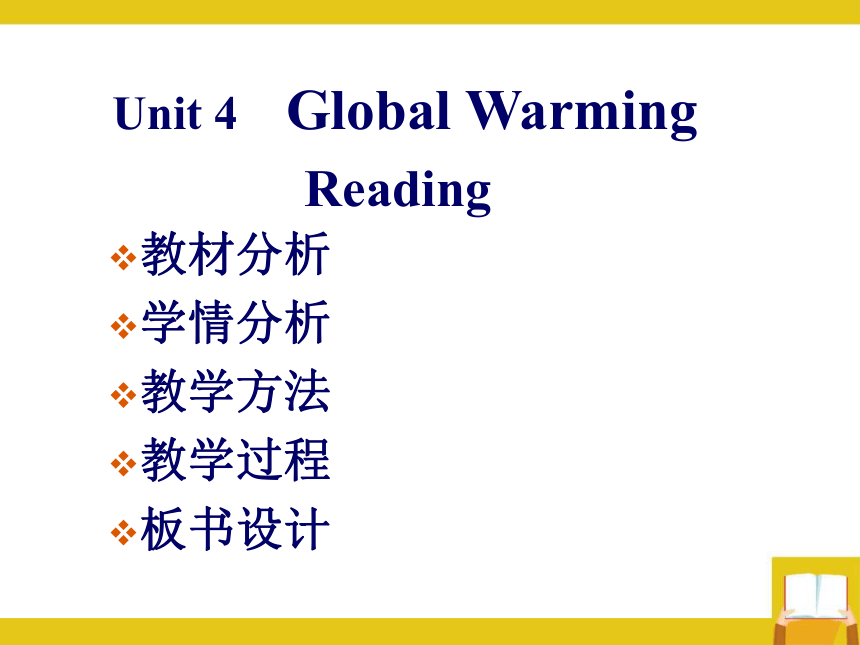 | |
| 格式 | zip | ||
| 文件大小 | 4.2MB | ||
| 资源类型 | 教案 | ||
| 版本资源 | 人教版(新课程标准) | ||
| 科目 | 英语 | ||
| 更新时间 | 2016-02-24 15:39:28 | ||
图片预览

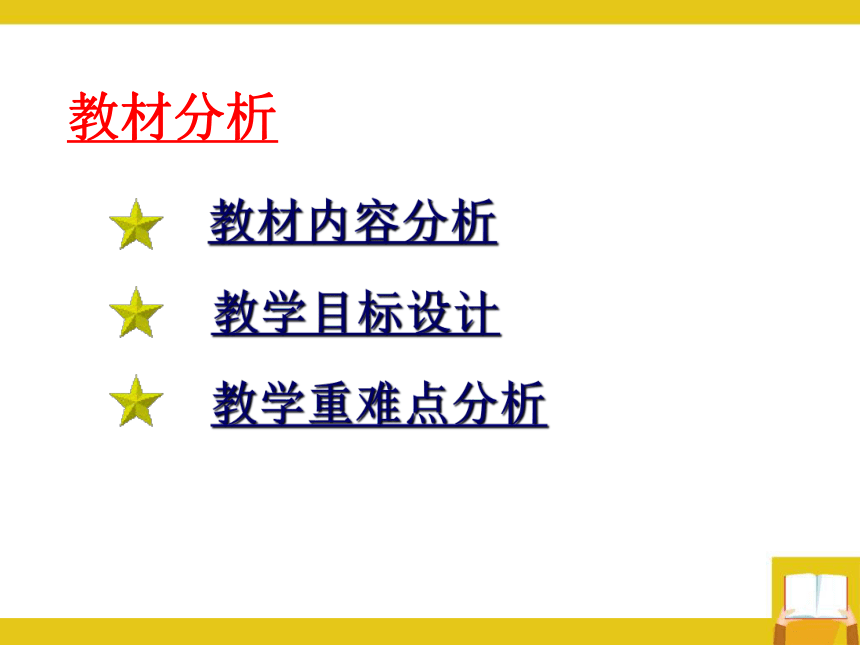
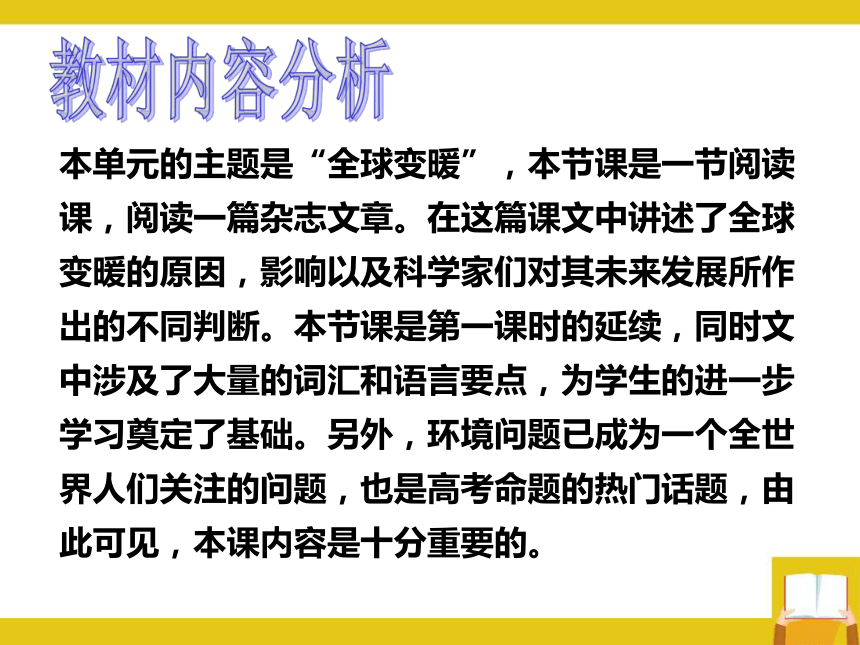
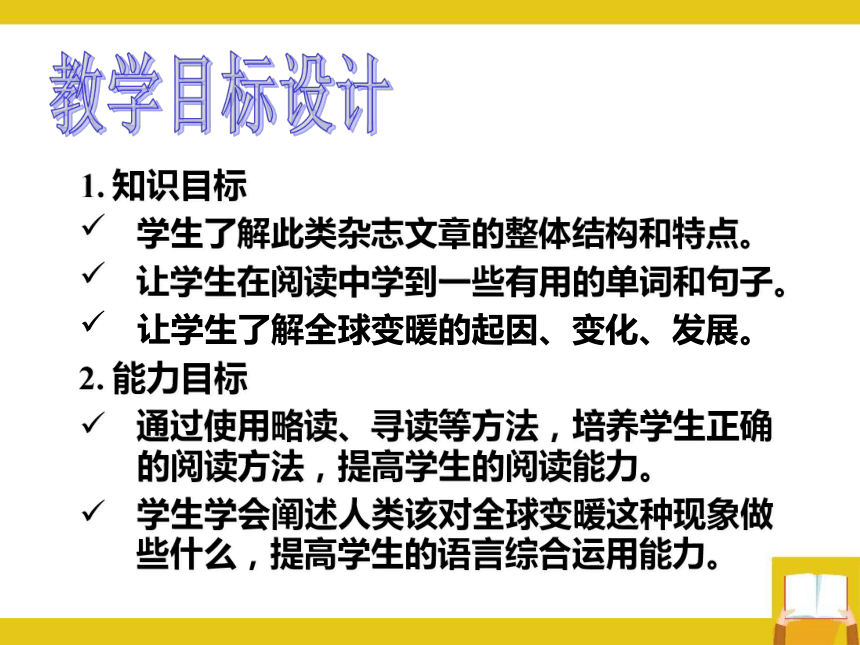
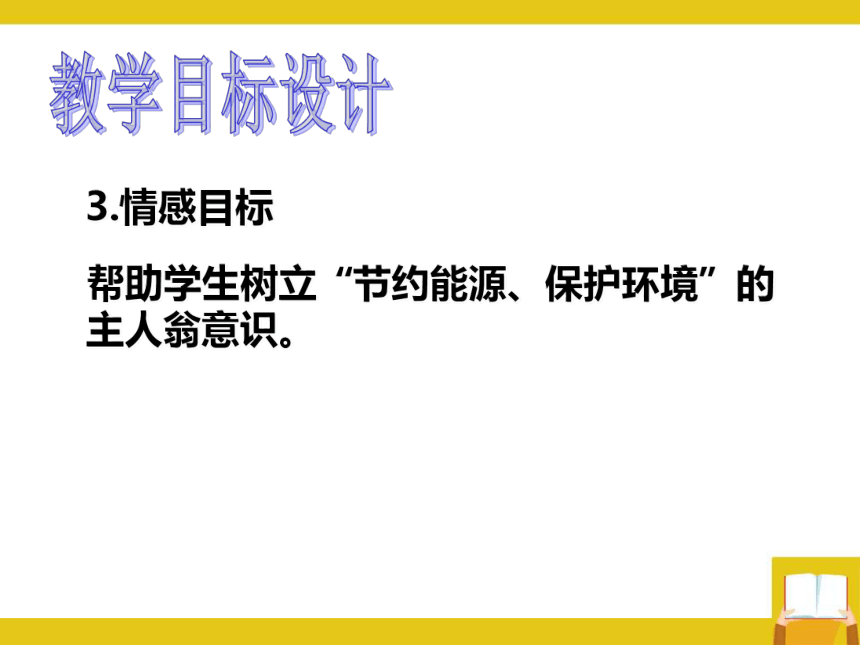
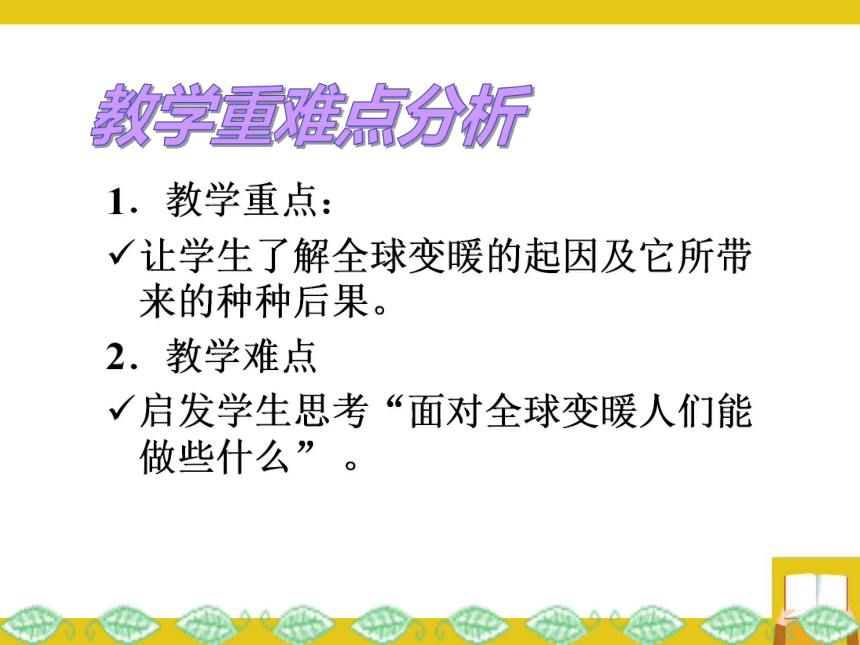
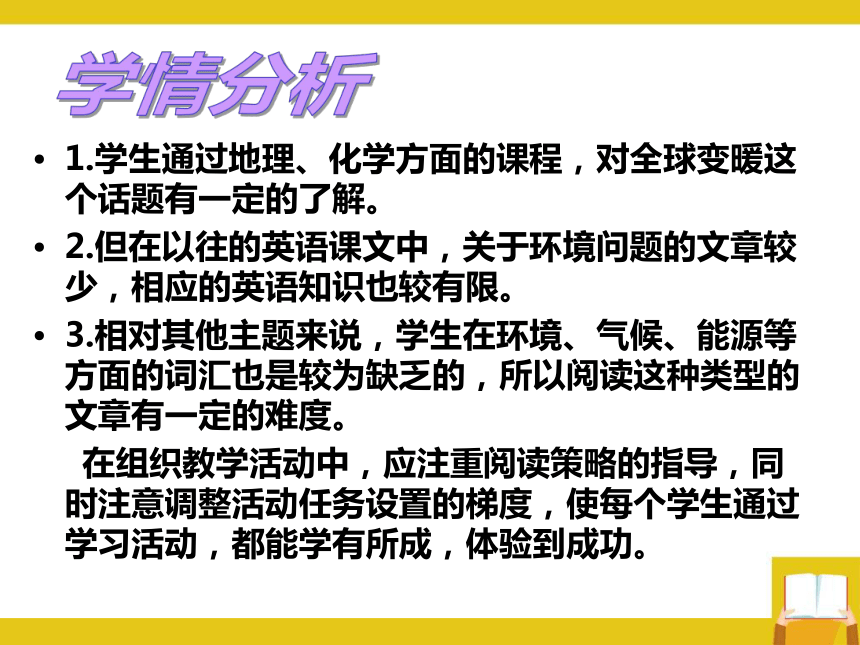
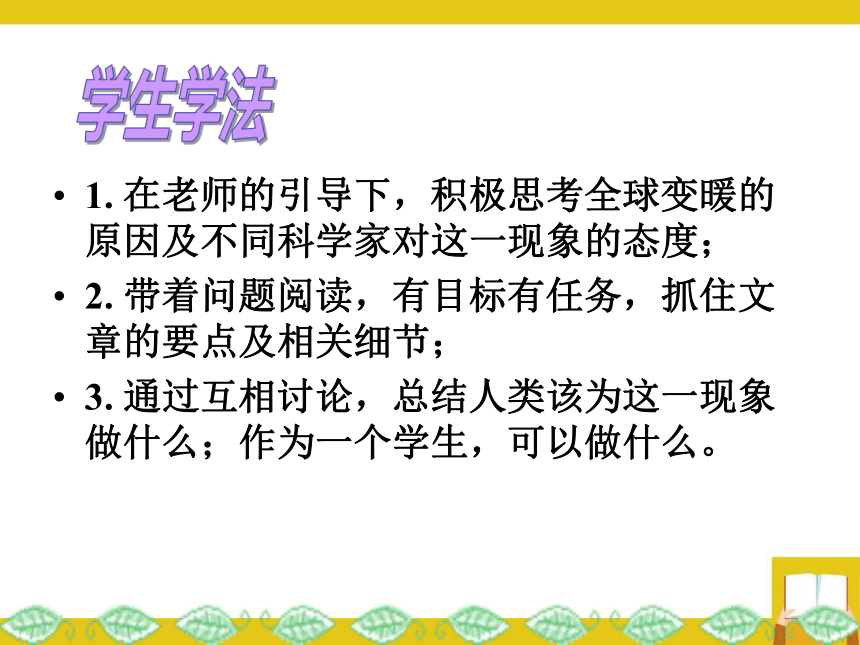
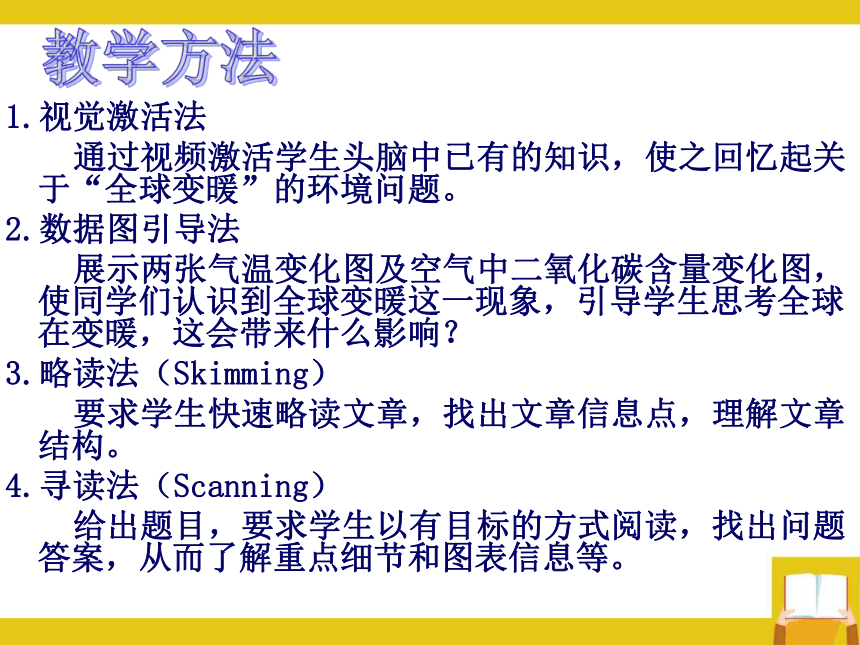
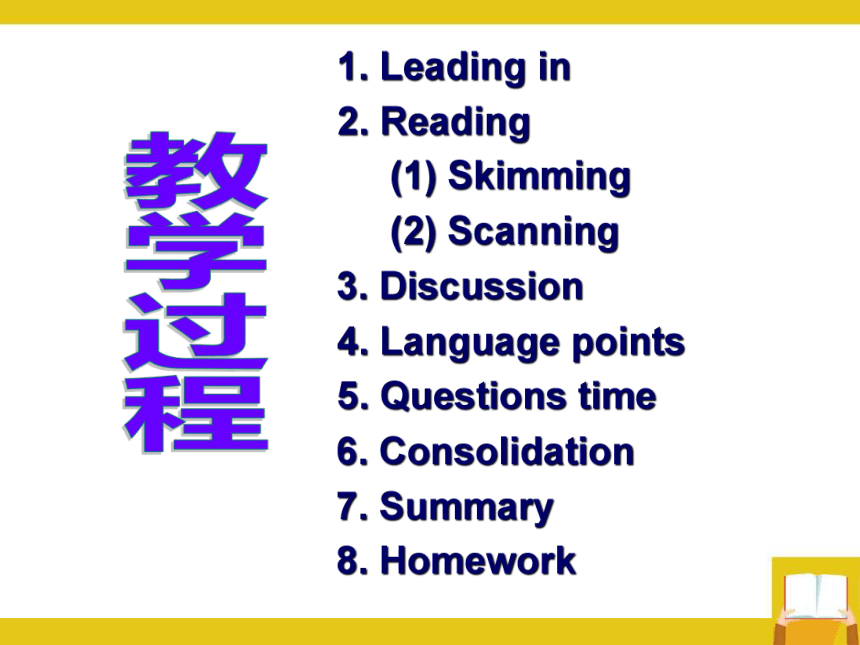
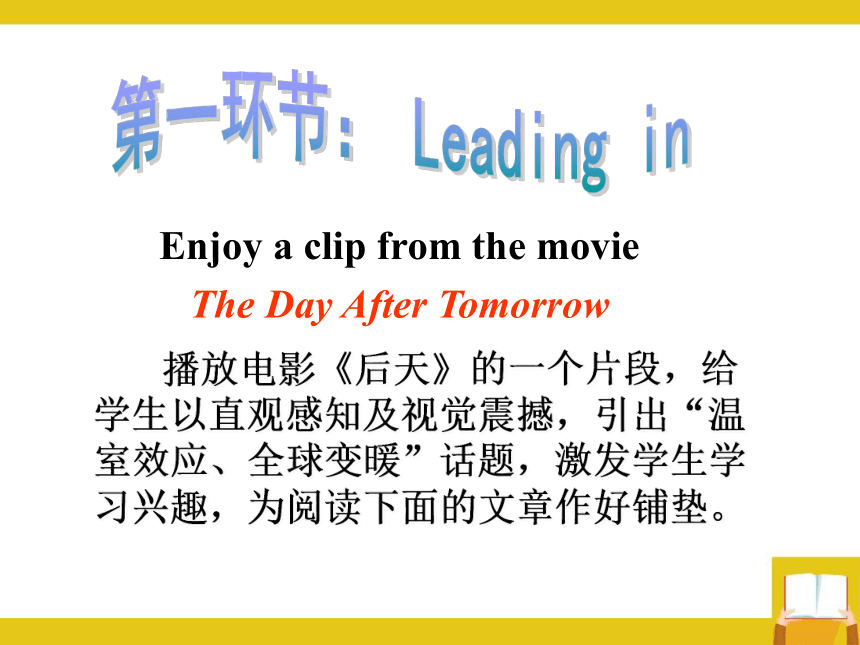
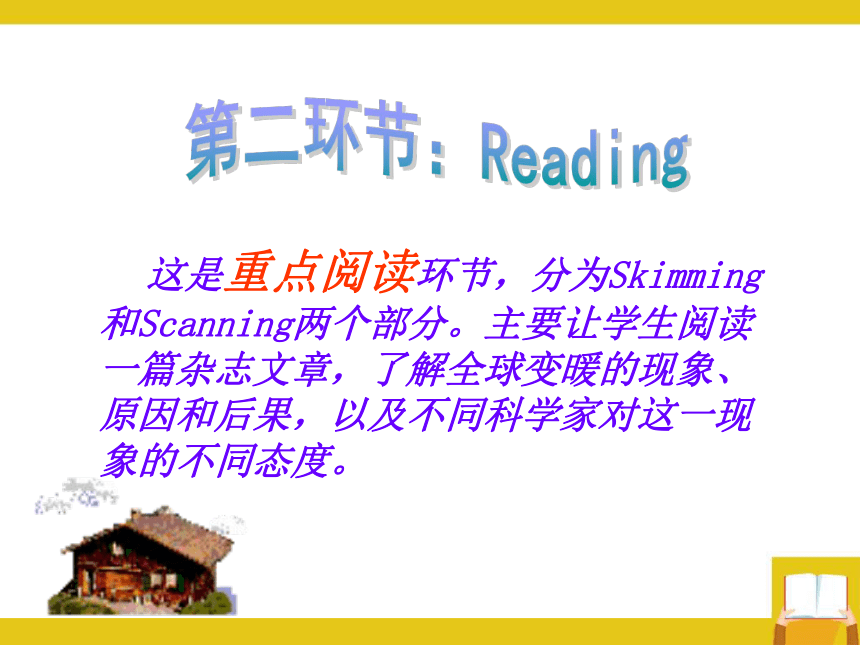
文档简介
课件46张PPT。 Unit 4 Global Warming Reading教材分析
学情分析
教学方法
教学过程
板书设计
教材内容分析教学目标设计教学重难点分析教材分析本单元的主题是“全球变暖”,本节课是一节阅读课,阅读一篇杂志文章。在这篇课文中讲述了全球变暖的原因,影响以及科学家们对其未来发展所作出的不同判断。本节课是第一课时的延续,同时文中涉及了大量的词汇和语言要点,为学生的进一步学习奠定了基础。另外,环境问题已成为一个全世界人们关注的问题,也是高考命题的热门话题,由此可见,本课内容是十分重要的。教材内容分析教学目标设计1. 知识目标
学生了解此类杂志文章的整体结构和特点。
让学生在阅读中学到一些有用的单词和句子。
让学生了解全球变暖的起因、变化、发展。
2. 能力目标
通过使用略读、寻读等方法,培养学生正确的阅读方法,提高学生的阅读能力。
学生学会阐述人类该对全球变暖这种现象做些什么,提高学生的语言综合运用能力。教学目标设计3.情感目标
帮助学生树立“节约能源、保护环境”的主人翁意识。1.教学重点:
让学生了解全球变暖的起因及它所带来的种种后果。
2.教学难点
启发学生思考“面对全球变暖人们能做些什么” 。教学重难点分析1.学生通过地理、化学方面的课程,对全球变暖这个话题有一定的了解。
2.但在以往的英语课文中,关于环境问题的文章较少,相应的英语知识也较有限。
3.相对其他主题来说,学生在环境、气候、能源等方面的词汇也是较为缺乏的,所以阅读这种类型的文章有一定的难度。
在组织教学活动中,应注重阅读策略的指导,同时注意调整活动任务设置的梯度,使每个学生通过学习活动,都能学有所成,体验到成功。学情分析
1. 在老师的引导下,积极思考全球变暖的原因及不同科学家对这一现象的态度;
2. 带着问题阅读,有目标有任务,抓住文章的要点及相关细节;
3. 通过互相讨论,总结人类该为这一现象做什么;作为一个学生,可以做什么。学生学法1.视觉激活法
通过视频激活学生头脑中已有的知识,使之回忆起关于“全球变暖”的环境问题。
2.数据图引导法
展示两张气温变化图及空气中二氧化碳含量变化图,使同学们认识到全球变暖这一现象,引导学生思考全球在变暖,这会带来什么影响?
3.略读法(Skimming)
要求学生快速略读文章,找出文章信息点,理解文章结构。
4.寻读法(Scanning)
给出题目,要求学生以有目标的方式阅读,找出问题答案,从而了解重点细节和图表信息等。教学方法 教学过程1. Leading in
2. Reading
(1) Skimming
(2) Scanning
3. Discussion
4. Language points
5. Questions time
6. Consolidation
7. Summary
8. Homework
播放电影《后天》的一个片段,给学生以直观感知及视觉震撼,引出“温室效应、全球变暖”话题,激发学生学习兴趣,为阅读下面的文章作好铺垫。第一环节: Leading inEnjoy a clip from the movie
The Day After Tomorrow
这是重点阅读环节,分为Skimming和Scanning两个部分。主要让学生阅读一篇杂志文章,了解全球变暖的现象、原因和后果,以及不同科学家对这一现象的不同态度。第二环节:Reading
通过略读,让学生了解杂志文章的特点,文章的整体结构和主要内容,从而使学生知道从整体上把握此类文章的方法,以及提高学生从文章中迅速获取信息的能力。 Skimming Look at the form of the article. Where can you most probably read this passage?
A. A novel
B. A fairy tale
C. A student’s composition
D. A magazineFeatures of This Magazine Article 1a title2an opening paragraph3two graphs4main text in two columns5two quotesAnswer the questions What is the purpose of the first paragraph?
2. What is the main topic of the article?
3. What are the graphs for?
4. Why are there two quotes?
5. What is the purpose of the last paragraph of the article?The organization of the article: IntroductionA titleBodyConclusionDivide the text into three parts:Para. 1Para. 2-5IIIPara. 6IIIPara. 7IVIntroduction Body ConclusionMain ideas of each part and the writing techniques:Part1
(1)Introduce a debate over the issue of global warming. Raising a
questionPart2
(2-5)How global warming
comes about.Giving
examples,
using graphs,
explanation List two different attitudes
among scientists towards
global warming.It's up to readers to think and
decide whether people should
do something about global
warming or not.Giving examples, making contrastUsing a question, leaving readers to think over the issue. 此环节通过寻读,了解全球变暖的原因和后果,以及不同科学家对这一现象的不同态度。Scanning Read the title and the opening paragraph, then answer the following questions:1.Who wrote the article?2.What is the name of the magazine?Tip: In English, some nouns begin with a capital letter, such as names of people and places, titles of magazines, newspapers, stories and books, etc..
Sophie Armstrong
Earth Care1. Who wrote this article?2. What is the name of the magazine?What has caused global warming? Para.2What can we learn from graph1?Graph 1 shows the temperature difference on average from 1860 to 2000.It shows the temperature increase of one degree Fahrenheit between 1860 and 2000.Para.3To begin with,the increase of the earth’s temperature is due to _______________________.
the burning of fossil fuelsIn addition, some byproducts of the burning process are called _______________, the most important one of which is ____________.“greenhouse” gasescarbon dioxidegreenhouse effectFill in the blanks about the causes of greenhouse effect.henomenon uantitiesuels rapped esultingCharles Keeling’s measurements Para.4The graph shows that…What does Dr. Janice Foster say?Para.5How high will the temperature increase go?She says that over the next ___ years the amount of warming could be as low as__ to __ degrees Celsius ,but it could be as high as___ degrees. 10011.5 5
Different attitudes to the riseThe _____ that the temperature increases by five degrees would be a ___________ and it could be very _______.We should not worry about it. Any warming will be ____ with few bad________________________________. It is actually a ________ thing.trend seriousmildenvironmentalpositiveJaniceFosterGeorge HambleycatastropheconsequencesPara.6cause the sea level to rise
severe storms
droughts/floods
famines
the spread of diseases
disappearance of speciesPositive effects Negative effects cause the sea level to rise
severe storms
droughts/floods
famines
the spread of diseases
disappearance of speciesPositive effects Negative effects make plants grow faster
crops will produce more
a greater range of animals
make life better
…Para.7ConclusionUse questions, leaving readers to think over the issueABA : We shall do something about global warming.B: We shall do nothing about global warming.
The earth is becoming warmer- but does it matter?
学生通过讨论,阐述人类以及他们作为学生该对全球变暖这种现象做些什么,提高学生的语言综合运用能力,并帮助学生树立“节约能源、保护环境”的主人翁意识。
第三环节:DiscussionWhat can we do about global warming?1. … but it is a rapid increase when compared to other natural changes.
2. All scientists subscribe to the view that the increase in the earth’s temperature is due to the burning of …
3. On the one hand, … On the other hand, … 此环节是为了帮助学生解决本课中的一些较难句子,以便让他们更好地理解文章。第四环节 Language points 此环节的目的是为了帮助学生扫清在阅读过程中遇到的一些障碍。第五环节
Questions time让学生自由提问第六环节
ConsolidationAsk the students to retell the passage using their own words.
The students will first retell it to themselves and then retell it to their partners. 通过复述课文,让学生把课上所学用口头的形式再输出,训练了他们说的能力,同时让学生回顾并巩固了课上所学知识。 第七环节 SUMMARY1. Summarize the main idea of the passage.
2. Summarize the features of this magazine article. 通过这个环节,进一步精炼地概括所学文章的主要内容。总结此类文章的写作特点,让学生明白这类文章的写作方法,为今后的写作打下基础。通过写作进一步锻炼学生的语言运用能力,帮助学生树立“节约能源、保护环境”的主人翁意识。 Ask the students to write a short passage about what we can do about global warming.THE EARTH IS BECOMING WARMER- BUT DOES IT MATTER?
global warming human activity
the burning of fossil fuels greenhouse gases carbon dioxide
catastrophe or a positive thing
do something or do nothing
low carbon living
板书设计
学情分析
教学方法
教学过程
板书设计
教材内容分析教学目标设计教学重难点分析教材分析本单元的主题是“全球变暖”,本节课是一节阅读课,阅读一篇杂志文章。在这篇课文中讲述了全球变暖的原因,影响以及科学家们对其未来发展所作出的不同判断。本节课是第一课时的延续,同时文中涉及了大量的词汇和语言要点,为学生的进一步学习奠定了基础。另外,环境问题已成为一个全世界人们关注的问题,也是高考命题的热门话题,由此可见,本课内容是十分重要的。教材内容分析教学目标设计1. 知识目标
学生了解此类杂志文章的整体结构和特点。
让学生在阅读中学到一些有用的单词和句子。
让学生了解全球变暖的起因、变化、发展。
2. 能力目标
通过使用略读、寻读等方法,培养学生正确的阅读方法,提高学生的阅读能力。
学生学会阐述人类该对全球变暖这种现象做些什么,提高学生的语言综合运用能力。教学目标设计3.情感目标
帮助学生树立“节约能源、保护环境”的主人翁意识。1.教学重点:
让学生了解全球变暖的起因及它所带来的种种后果。
2.教学难点
启发学生思考“面对全球变暖人们能做些什么” 。教学重难点分析1.学生通过地理、化学方面的课程,对全球变暖这个话题有一定的了解。
2.但在以往的英语课文中,关于环境问题的文章较少,相应的英语知识也较有限。
3.相对其他主题来说,学生在环境、气候、能源等方面的词汇也是较为缺乏的,所以阅读这种类型的文章有一定的难度。
在组织教学活动中,应注重阅读策略的指导,同时注意调整活动任务设置的梯度,使每个学生通过学习活动,都能学有所成,体验到成功。学情分析
1. 在老师的引导下,积极思考全球变暖的原因及不同科学家对这一现象的态度;
2. 带着问题阅读,有目标有任务,抓住文章的要点及相关细节;
3. 通过互相讨论,总结人类该为这一现象做什么;作为一个学生,可以做什么。学生学法1.视觉激活法
通过视频激活学生头脑中已有的知识,使之回忆起关于“全球变暖”的环境问题。
2.数据图引导法
展示两张气温变化图及空气中二氧化碳含量变化图,使同学们认识到全球变暖这一现象,引导学生思考全球在变暖,这会带来什么影响?
3.略读法(Skimming)
要求学生快速略读文章,找出文章信息点,理解文章结构。
4.寻读法(Scanning)
给出题目,要求学生以有目标的方式阅读,找出问题答案,从而了解重点细节和图表信息等。教学方法 教学过程1. Leading in
2. Reading
(1) Skimming
(2) Scanning
3. Discussion
4. Language points
5. Questions time
6. Consolidation
7. Summary
8. Homework
播放电影《后天》的一个片段,给学生以直观感知及视觉震撼,引出“温室效应、全球变暖”话题,激发学生学习兴趣,为阅读下面的文章作好铺垫。第一环节: Leading inEnjoy a clip from the movie
The Day After Tomorrow
这是重点阅读环节,分为Skimming和Scanning两个部分。主要让学生阅读一篇杂志文章,了解全球变暖的现象、原因和后果,以及不同科学家对这一现象的不同态度。第二环节:Reading
通过略读,让学生了解杂志文章的特点,文章的整体结构和主要内容,从而使学生知道从整体上把握此类文章的方法,以及提高学生从文章中迅速获取信息的能力。 Skimming Look at the form of the article. Where can you most probably read this passage?
A. A novel
B. A fairy tale
C. A student’s composition
D. A magazineFeatures of This Magazine Article 1a title2an opening paragraph3two graphs4main text in two columns5two quotesAnswer the questions What is the purpose of the first paragraph?
2. What is the main topic of the article?
3. What are the graphs for?
4. Why are there two quotes?
5. What is the purpose of the last paragraph of the article?The organization of the article: IntroductionA titleBodyConclusionDivide the text into three parts:Para. 1Para. 2-5IIIPara. 6IIIPara. 7IVIntroduction Body ConclusionMain ideas of each part and the writing techniques:Part1
(1)Introduce a debate over the issue of global warming. Raising a
questionPart2
(2-5)How global warming
comes about.Giving
examples,
using graphs,
explanation List two different attitudes
among scientists towards
global warming.It's up to readers to think and
decide whether people should
do something about global
warming or not.Giving examples, making contrastUsing a question, leaving readers to think over the issue. 此环节通过寻读,了解全球变暖的原因和后果,以及不同科学家对这一现象的不同态度。Scanning Read the title and the opening paragraph, then answer the following questions:1.Who wrote the article?2.What is the name of the magazine?Tip: In English, some nouns begin with a capital letter, such as names of people and places, titles of magazines, newspapers, stories and books, etc..
Sophie Armstrong
Earth Care1. Who wrote this article?2. What is the name of the magazine?What has caused global warming? Para.2What can we learn from graph1?Graph 1 shows the temperature difference on average from 1860 to 2000.It shows the temperature increase of one degree Fahrenheit between 1860 and 2000.Para.3To begin with,the increase of the earth’s temperature is due to _______________________.
the burning of fossil fuelsIn addition, some byproducts of the burning process are called _______________, the most important one of which is ____________.“greenhouse” gasescarbon dioxidegreenhouse effectFill in the blanks about the causes of greenhouse effect.henomenon uantitiesuels rapped esultingCharles Keeling’s measurements Para.4The graph shows that…What does Dr. Janice Foster say?Para.5How high will the temperature increase go?She says that over the next ___ years the amount of warming could be as low as__ to __ degrees Celsius ,but it could be as high as___ degrees. 10011.5 5
Different attitudes to the riseThe _____ that the temperature increases by five degrees would be a ___________ and it could be very _______.We should not worry about it. Any warming will be ____ with few bad________________________________. It is actually a ________ thing.trend seriousmildenvironmentalpositiveJaniceFosterGeorge HambleycatastropheconsequencesPara.6cause the sea level to rise
severe storms
droughts/floods
famines
the spread of diseases
disappearance of speciesPositive effects Negative effects cause the sea level to rise
severe storms
droughts/floods
famines
the spread of diseases
disappearance of speciesPositive effects Negative effects make plants grow faster
crops will produce more
a greater range of animals
make life better
…Para.7ConclusionUse questions, leaving readers to think over the issueABA : We shall do something about global warming.B: We shall do nothing about global warming.
The earth is becoming warmer- but does it matter?
学生通过讨论,阐述人类以及他们作为学生该对全球变暖这种现象做些什么,提高学生的语言综合运用能力,并帮助学生树立“节约能源、保护环境”的主人翁意识。
第三环节:DiscussionWhat can we do about global warming?1. … but it is a rapid increase when compared to other natural changes.
2. All scientists subscribe to the view that the increase in the earth’s temperature is due to the burning of …
3. On the one hand, … On the other hand, … 此环节是为了帮助学生解决本课中的一些较难句子,以便让他们更好地理解文章。第四环节 Language points 此环节的目的是为了帮助学生扫清在阅读过程中遇到的一些障碍。第五环节
Questions time让学生自由提问第六环节
ConsolidationAsk the students to retell the passage using their own words.
The students will first retell it to themselves and then retell it to their partners. 通过复述课文,让学生把课上所学用口头的形式再输出,训练了他们说的能力,同时让学生回顾并巩固了课上所学知识。 第七环节 SUMMARY1. Summarize the main idea of the passage.
2. Summarize the features of this magazine article. 通过这个环节,进一步精炼地概括所学文章的主要内容。总结此类文章的写作特点,让学生明白这类文章的写作方法,为今后的写作打下基础。通过写作进一步锻炼学生的语言运用能力,帮助学生树立“节约能源、保护环境”的主人翁意识。 Ask the students to write a short passage about what we can do about global warming.THE EARTH IS BECOMING WARMER- BUT DOES IT MATTER?
global warming human activity
the burning of fossil fuels greenhouse gases carbon dioxide
catastrophe or a positive thing
do something or do nothing
low carbon living
板书设计
